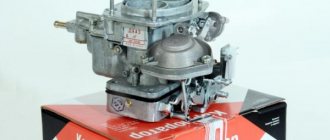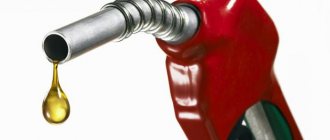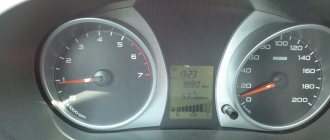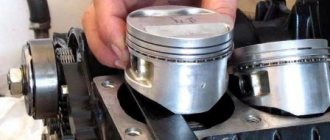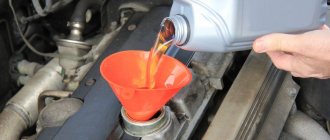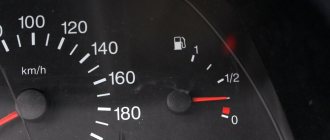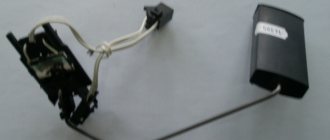One of the main aspects of a car is the amount of gasoline consumed per 100 km. For VAZ-21213 this indicator has a double meaning. On the one hand, the Niva 21213 has lower fuel consumption than other SUVs. On the other hand, for a 1.7-liter engine, whose power does not exceed 90 hp, it could be lower.
Niva's fuel consumption is acceptable
Fuel consumption is the most important indicator on the basis of which the decision to purchase a Niva is made. The technical data sheet provides an estimate for traveling a distance of 100 kilometers. At the same time, it is necessary to understand that the actual level of consumption is different, since its level is influenced by many indicators. These include different weather conditions, road surface quality and different driving styles.
Since the difference in fuel consumption between different engine modifications is not very different, we present the average values for the Niva. What is the fuel consumption of the Niva:
- When traveling in a mixed cycle city - highway - 9.8-10.3 l;
- Driving outside the city, on the highway - 8.1-8.6 l;
- In a large city, in heavy traffic - 12.0-12.4 liters.
These values are of a calculated nature; they are measured in factory measuring laboratories in accordance with special GOST standards. Therefore, you can simply rely on these indicators - they are not the norm when used in real conditions.
If we analyze the operating experience of the owners, it turns out that real gasoline consumption figures fluctuate around 1.5-15.5 liters. At the same time, carburetor versions consume slightly more than injection models.
What determines fuel consumption and how to reduce it?
There are several reasons why the engine becomes more power hungry:
- The gasoline consumption of engines primarily depends on its condition, as well as on the condition of the carburetor. If the carburetor becomes clogged, consumption increases very significantly. The same thing happens if engine compression decreases;
- The quality of gasoline is a very, very important factor. There is no need to refuel at some unknown gas station - and more gasoline will be consumed, and the fuel filters will have to be changed very quickly. It's better to choose a couple of really good gas stations and try to refuel there;
- Take care of the cleanliness of the fuel system and regularly clean the jets;
- If the tire pressure is less than required, the contact patch with the surface increases - accordingly, the engine has to spend more energy and gasoline;
- Replace spark plugs regularly, especially when using AI-80 gasoline - their service life is up to 10,000 km.
- Check the condition of the trampler, slider and wires;
- Remove unnecessary elements from the body - they increase aerodynamic drag and gasoline consumption;
- Use an economical driving style - there is no need to sharply accelerate and brake the car if you can move evenly, with smooth acceleration and braking by inertia.
- It is worth mentioning economizers , but they do not bring the desired result.
Carburetor engines
There are two versions of Niva with carburetor engines. These are the following models:
- VAZ 2121 with a 1.6 four-cylinder power plant with a power of 80 horsepower. Produces a torque of 116 N*m, guaranteeing a maximum speed of 132-133 km/h;
- VAZ 21213 with a 1.7 four-cylinder engine producing 82 horses. This version of the power plant is capable of accelerating the car to 100 km/h in 17 seconds.
The average fuel consumption of engines with a carburetor gasoline injection system is higher. Carburetors also require constant maintenance and fine tuning.
Niva 21213
When developing this model, the designers planned to call it the code name “Taiga”. In fact, it was a restyling of the classic design - the doors, optics and body were redesigned. The power plant was improved - a 1.7-liter engine was installed, which produced 83 horsepower with a torque of 125 N*m. The gasoline dosing system is based on a carburetor. Transmission – five-speed, manual. The consumption indicators were:
- When driving outside the city - 8.1-8.5 l;
- Driving on busy city streets - 11.3-11.7 l;
- When traveling intercity and in the urban cycle - 9.0-9.5 liters.
In addition to carburetor models, an injection version is also available for 21213, the consumption figures of which are practically no different from the carburetor version.
Official data (l/100 km)
| Engine | Consumption (city) | Consumption (highway) | Flow (mixed) |
| 1.6 MT 73 hp (Mechanics) | 13.4 | 7.8 | 9.8 |
| 1.6 MT 75 hp (Mechanics) | 13.4 | 7.8 | 9.8 |
| 1.7 MT 79 hp (Mechanics) | 11.5 | 8.3 | 9.1 |
| 1.7 MT 80 hp (Mechanics) | 13.5 | 10.8 | 11.8 |
| 1.7 MT 83 hp (Mechanics) | 11.2 | 8.3 | 9.7 |
| 1.9 MT 75 hp diesel (mechanics) | 11.7 | 7.6 | 9.8 |
The main engine that is equipped with the Lada 2121 has a volume of 1.7 liters. It produces 83 horsepower. The injector is responsible for supplying fuel. Fuel consumption per 100 km for this version is 11.3 liters in the city and 8.4 liters on the highway.
Another engine is 1.6 liters. Its peak power is 73 horsepower, however, the carburetor is responsible for the fuel here. Gasoline consumption is at 10.1 liters. There is also a diesel engine that can produce 75 horsepower and consume 9.9 liters of fuel. The gearbox is a standard VAZ five-speed manual.
Niva 2121
This variation of the Niva was put on the assembly line between 1977 and 1993. There is a standard 1.6 4-cylinder engine with a power of 80 horses. The maximum speed for this engine is 130 km/h.
As for the characteristics of gasoline consumption, the following values are noted:
- When driving on the highway - 7.7-7.9 l;
- In urban conditions - 13.2-13.8 l;
- In the combined cycle on the highway and in the city - 9.6-9.9 liters.
Models with such technical characteristics are still in service and are often found on the roads. The reason for this is the low fuel consumption of the VAZ 21214.
Niva 2131
A modified version of the 2121 was released in the mid-nineties. It had the code VAZ 2131 and the informal name “5D”. The body was modified, where 5 doors were now placed. In general, it has become longer due to the lengthening of the wheelbase, which has become 125 mm longer. Due to such design changes, the weight of the vehicle increased, which was reflected in increased fuel consumption:
- When driving at a speed of 90-100 km/h on the highway - 9.5-9.9 liters;
- Traveling in heavy city traffic – 13.5-13.9 l;
- When driving in a mixed cycle - 12.0-12.8 liters per 100 km.
The basic configuration includes an engine with a carburetor fuel metering system, developing 80 horsepower, complete with a manual transmission. There is also a version with an injector. The fuel consumption of the VAZ 21213 is as follows:
- Driving on the highway - 9.5-9.8 l;
- Driving in urban conditions – 13.1-13.7 l;
- When driving both in the city and on the highway - 10.4-10.7 liters.
What is the fuel consumption of Lada 4×4 (VAZ 2121 and VAZ 2131)
Before buying a car, you should understand what costs will be required to maintain it. Therefore, the manufacturer in the technical specifications indicates fuel consumption data in liters per 100 km. Let's find out what numbers are indicated in the Lada 4x4 documentation and what values are found in practice during the operation of an SUV.
On the official website AvtoVAZ indicates the following fuel consumption per 100 km for Lada 4×4:
- Urban cycle - 12.1 l/100km
- Extra-urban cycle – 8.3 l/100km
- Mixed cycle – 10 l/100km
These values are the same for all Lada 4x4 injectors (3-door, 5-door and “Urban”).
The manufacturer notes that fuel consumption data was determined under standardized conditions using special measuring equipment, in accordance with the requirements of GOST R41.101–99 (UNECE Rules No. 101). Used to compare cars from different automakers. They are not an operational standard.
Currently, the plant does not produce Lada with a carburetor engine, so the figures were found in the operating, maintenance and repair manual for the Lada 4×4 car for 2005. There is a detailed table with fuel consumption for this SUV:
| Options | VAZ-2129 | VAZ-2129-01 | VAZ-2130 | VAZ-2131 | VAZ-21312 | VAZ-2131-01 | VAZ-21312-01 |
| Engine | VAZ-21213 | VAZ-21213 | VAZ-21213 | VAZ-21213 | VAZ-2130 | VAZ-21213 | VAZ-2130 |
| Gasoline consumption per 100 km when driving in top gear, no more than, l | |||||||
| at a speed of 90 km/h | 10,3 | 10,3 | 10,3 | 9,1 | 9,3 | 9,1 | 9,3 |
| at a speed of 120 km/h | 11,8 | 11,8 | 11,8 | 12,1 | 12,3 | 12,1 | 12,3 |
| during urban driving cycle | 12,3 | 12,3 | 12,3 | 11,1 | 11,9 | 11,1 | 11,9 |
We also provide data on fuel consumption for different types of engines from Wikipedia:
- VAZ-2121 (carburetor): 10.8-13.4 l/100 km
- VAZ-21213 (carburetor): 8.3-11.5 l/100 km
- VAZ-21214 (injector): 8-9.1 l/100 km
Thus, fuel consumption on a Lada 4x4 (injector) is slightly less than with a carburetor. It is worth noting that reviews from owners of this SUV indicate that in practice the numbers may be higher. It is not uncommon to see fuel consumption of 14 l/100 km or even 15 l/100 km on a Lada 4x4.
How to reduce fuel consumption:
- Change your driving style, make acceleration smoother, and do not exceed speeds above 80..90 km/h.
- Drive more often on flat roads. On off-road, fuel consumption is significantly higher.
- Use additional electrical equipment of the car less often. For example, air conditioning, heated seats, etc.
- There may be problems with the engine. Perform diagnostics and troubleshoot problems.
- Fuel consumption on AI95 is less than on AI92.
It is worth remembering that high or increased fuel consumption is observed in winter, when the engine warms up for some time before driving.
What is the average fuel consumption on your Lada 4x4 SUV? Do you have any tips to help reduce these numbers? Let us remind you that fuel consumption also depends on the type of gasoline, so the majority of owners recommend using AI95.
Owner reviews
Nikita from Zheleznogorsk. I have been the owner of a Niva 4x4 for over 10 years. I inherited it, and at first I had to spend money on maintenance - suspension repairs, cleaning and adjusting the carburetor. After all this, my consumption in the city is about 14 liters per hundred. I run the 92nd.
Vladislav from Ufa. An inexpensive SUV was required for hunting and fishing trips. As a result, I bought a used Niva with a carburetor and a 1.6 engine. I was pleased that 80 horses are more than enough both in the city and for cross-country trips. My consumption figures are 12-13 liters.
Semyon from Smolensk. I have owned a Lada 4x4 for about 5-6 years. I bought it used with a mileage of 130,000 kilometers. In general, the feeling is positive - a reliable, passable car. Gasoline consumption is at 11-12 per hundred.
Good old SUV
The Niva 21214 car has proven to be a successful project, combining the cross-country capabilities of an all-terrain vehicle and the comfortable elements of a passenger car.
It is perfect for weekend trips out of town, weekend trips for fishing or hunting. And even the considerable costs of using a vase cannot upset lovers of this particular car model.
Hello friends ! Let's discuss how to reduce Niva consumption using simple but effective actions. Despite the stable rise in fuel prices today, you can save by reducing fuel consumption. Here are some fuel-saving options that will increase your vehicle's mileage on a single tank. One of the best ways to save fuel is to buy gasoline in bulk. Wholesale is always cheaper, so you can buy fuel either in bulk or using discount coupons. This way you can save a small amount per 1 liter.


